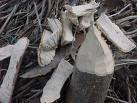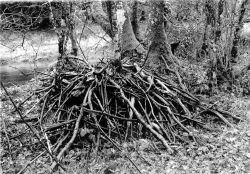As a Wildlife manager and lover of all sorts of wildlife and nature it would only be natural of me to welcome the proposed reintroduction of European beavers in Scotland.
However, as I am convinced that the reintroduction will cause conflicts with other interests, I will have to be against the proposals, as it wouldn’t be right to put beavers through the stress of capture, transport, and radio tagging for the purpose of a trial which surely will cause problems.
SNH have tried this proposal before and it was, in my mind, rightly turned down. SNH stated in their earlier application, that the beavers would be monitored and that any beavers straying outside the trial area would be recaptured and brought back to the trial area.
SNH stated that beavers are very easy to trap. This is only true where beavers have established territories and runs, and the focus is on trapping a beaver out of a bigger population. Where beavers are roaming because of the lack of an established territory or because of being displaced by other beavers, it becomes much harder to trap individual beavers.
The fact that the beaver is known to be in the area, by radio tracking it assuming that the radio tracking works, only makes it marginally easier to trap it, as it could easily have moved on again the next day. In any case, radio transmitters can only be fitted onto the original beavers and not necessarily to their young ones.
Roy Dennis an independent ecologist has on numerous occasions stated that a forest without beavers is like running a car without oil! – Lets be serious, - Scotland has been running forestry successfully for many years without beavers, however Roy, try to run your car without oil for half an hour.
SNH has publicly requested that the Deer Commission for Scotland get their act together to control Scotland’s deer herd or they will themselves start to use their powers.
Yes, - deer cause damage to both commercial and natural woodlands and vegetation but this damage is mostly in the form of browsing, which only reduces the growth rate the trees, whereas the beaver kills every single tree that it is feeding on.
Each beaver will fell up to 2000 trees per year, in sizes varying from saplings to old mature trees. I have personally, during a trip to Norway, seen several oak trees, approximately 1’ thick, felled by beavers as well as an Aspen, which was 20” in diameter.
SNH also stated that beavers do not build dams like their American cousins. This has been taken by many to mean that European beavers do not build dams, which is incorrect. The European beavers do build dams, however not quite as big as the American beavers, but still big enough to cause problems. A former local SNH employee admitted that she was surprised to see the size of dams and the problems with the beavers, when she witnessed it for herself on a visit abroad.
Norwegian forest owners accepted the beavers for a number of years, as most trees felled by beavers are broad-leaved, which were regarded as weeds in the commercial conifer forest. However new markets for oak, birch and aspen changed the perception of the beaver and bounties were paid for killing beavers. The payment of bounties stopped after the Norwegians realised that they could get, especially Danish and German, hunters to pay for the right to shoot beavers. Ordinary people living in areas populated with beavers are still having to protect their ornamental garden trees and fruit trees with steel sheeting to a height of 4-5’, to avoid them being felled by beavers.
Swedish forest owners are having the same problems as the Norwegians. One report tells of a culvert being dammed by beaver in one knight, resulting in flooding that washed away 100 meters of the road, leading to a repair cost of SKr 600,000.00 (£40,000.00).
Denmark recently reintroduced the beaver and within one month of the reintroduction one of the beavers had travelled 20 miles and had, in one night, gone in to a garden, where it had felled all the garden owners’ fruit trees and all his Brussels sprouts. Danish authorities denied any liability, as it was a wild animal!
Germany also reintroduced the beaver and I have personally seen some of the problems in Bavaria, where the beavers have populated drainage canals in an arable area. This has led to farmers having to remove dams on a regular basis to avoid flooding. Additionally the beavers are burrowing in to the banks of the canals, causing the ground to subside when the farmer drives over the burrows with heavy machinery. I have been told that this has led to expensive repairs on at least one combine harvester.
In Germany, the owner of the hunting rights must pay compensation to farmers and forest owners for any damage caused by animals that can be hunted. This is to ensure that the hunters keep populations under control. In the case of the beaver, the German hunters have said that they do not want an open season for beavers, as they didn’t ask for the reintroduction and they don’t want the beavers to become their problem.
The idea of the reintroduction is now being aired again, this time by the Scottish Wildlife Trust and the Royal Zoological Society for Scotland; however the only change since the last application is that we now have a different minister in charge.
It beggars belief that wildlife organisations are so keen to spend vast sums on the reintroduction of beavers, which will be controversial and yet at the same time stand by and watch the decline of the Black grouse, and the spread of the Grey squirrel, without any real intervention other than just monitoring.
If the reintroduction was to go ahead, will the same bodies pushing for the reintroduction be prepared to pay compensation for any damage caused by the beavers?
It is not unthinkable that the beavers will find their way into the Crinan Canal, where burrows in the canal bank would be a serious issue. Likewise it is not unthinkable that flood damage akin to the Swedish example above would occur, and the beavers could easily travel further a field and cause damage in some of the wonderful botanical gardens that we have on the West coast of Scotland.
I do not have much knowledge of beaver fever, but with so much of the West coast Scotland’s drinking water being sourced from surface water, any risk, however slight, must not be allowed.
Subscribe to:
Post Comments (Atom)









3 comments:
What a skeptical and might I say paranoid website with mentions of poll sabotage by pro beaver activists.
Its acknowledged that European Beavers do damage and fell trees and build dams and its undeniable that in the short term this will damage the integrity of the current ecosystem in the Knapdale area however its also proven that the felling and damming actions of European Beaver increase biodiversity by increasing the area of wet woodland and slowing the flow of water which benefits some fish and freshwater invertebrates. In addition its proven that Salmonids are not inhibited by the construction of beaver dams.
For every action there will be consequences and of course there will be habitats that are changed by the arrival of the beavers, changed but not destroyed. Its likely they will become more diverse and increasingly valuable ecologically. No one knows if the reintrodcution trial will be a guaranteed success or a guaranteed failure, so why oppose a trial that will provide some much needed answers?
Had a good chuckle reading your website. Are you slightly deluded? Most of you arguments are not based on logic so there is no point attempting to provide a logical reposte to what are largely emotive arguments with little or no factual basis.
Hi,
I begin on internet with a directory
Post a Comment